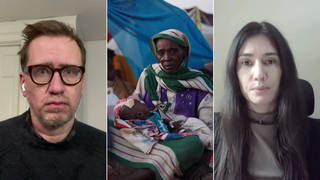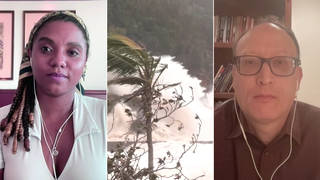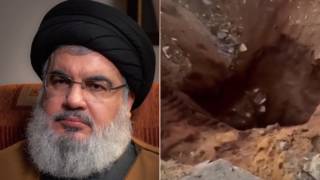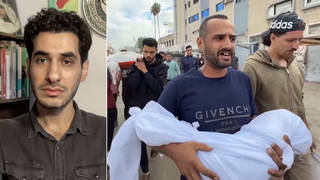
Guests
- Jan Egelandsecretary general of the Norwegian Refugee Council.
U.S. Secretary of State Antony Blinken met with Israeli Prime Minister Benjamin Netanyahu in Jerusalem today as a ceasefire between Israel and Hamas holds for a fifth day. Blinken is expected to meet with Palestinian President Mahmoud Abbas in Ramallah in the occupied West Bank. He will then head to Egypt and Jordan. Blinken is not planning to meet with anyone connected to Hamas or visit Gaza, which was devastated during the 11-day Israeli bombardment. The Israeli assault killed 253 Palestinians, including 66 children. During a joint appearance with Netanyahu, Blinken reconfirmed Israel’s right to self-defense and repeated President Biden’s vow to help rebuild Gaza.
To look more at the humanitarian crisis in Gaza, we’re joined by Jan Egeland, the secretary general of the Norwegian Refugee Council, which revealed last week that 11 of the children killed in Gaza were taking part in a program to help them deal with trauma from growing up in Gaza. Egeland is the former U.N. under-secretary-general for humanitarian affairs and U.N. emergency relief coordinator. He joins us from Goma in the Democratic Republic of the Congo.
Transcript
AMY GOODMAN: This is Democracy Now!, democracynow.org, The Quarantine Report. I’m Amy Goodman.
U.S. Secretary of State Antony Blinken met with Israeli Prime Minister Benjamin Netanyahu in Jerusalem today, as the ceasefire between Israel and Hamas holds for a fifth day. Blinken is expected to meet with Palestinian President Mahmoud Abbas in Ramallah in the occupied West Bank. He’ll then head to Egypt and Jordan. He is not planning to meet with anyone connected to Hamas or visit Gaza, which was devastated during the 11-day Israeli bombardment. The Israeli assault killed 253 Palestinians, including 66 children. During a joint appearance with Netanyahu, Blinken reconfirmed Israel’s right to self-defense and repeated President Biden’s vow to help rebuild Gaza.
To look more at the humanitarian crisis in Gaza, we’re joined by Jan Egeland, the secretary general of the Norwegian Refugee Council. Last week, the council revealed 11 of the children killed in Gaza were taking part in a program to help them deal with trauma from growing up in Gaza. Jan Egeland is the former U.N. under-secretary-general for humanitarian affairs and U.N. emergency relief coordinator. He’s joining us from Goma in the Democratic Republic of the Congo, dealing with a volcano right now. We’ll talk about that in a moment. But we’re going to start with what’s happening right now in Gaza.
Jan, thanks so much for being with us. The U.N. secretary-general, António Guterres, said, quote, “If there is a hell on Earth, it is the lives of children in Gaza today.” Tell us what you understand is happening there now.
JAN EGELAND: Well, Gaza has become the home of hopelessness, where people are crammed together, 2 million people, in a tiny place. It’s smaller than the municipality of Oslo, where I normally live. There is no way people can leave the place. Israel and Egypt control the borders, and they don’t let anybody out, really. They let only a bit of humanitarian aid in.
During this onslaught, we didn’t only have the 11 ones you talked about, Amy. There was a 12th little girl killed. All of those, we were trying to treat for trauma from the previous conflicts. There’s been five wars since 2006. So, a child would have grown up with nothing but violence, nothing but hopelessness. That’s why we need Blinken and Biden and the leadership of the U.S. now to lead to a solution to this senseless repeat of conflicts where Palestinian children die.
AMY GOODMAN: So, you have the United States providing the weapons for Israel to bomb Gaza and now committing to the rebuilding of Gaza. Can you talk about the problem with this?
JAN EGELAND: Well, it seems futile, really. There seems to be a logical third path — namely, for the U.S. to lead the international community — the U.S., Europe and the Arab countries — to have some kind of an arbitration, when you have an Israeli leadership and Palestinian leaderships incapable of solving the underlying conflicts that lead to repeat violence and insecurity for both peoples. So, could the U.S. lead us, please, in reaching, you know, political solutions, an end to the occupation and so on? We just had an earthquake here in Goma. That’s why it’s shaking.
We need in Gaza to have an end to this serving hopelessness to children, who will grow up with more and more bitterness and chaos. And I’m telling you, we humanitarian workers are sick and tired of building and rebuilding and see it all torn down again.
AMY GOODMAN: You co-signed a letter with 11 other heads of international humanitarian organizations to Secretary of State Blinken about the situation in Gaza. Talk about the issues you’ve raised. I mean, you had this constant bombardment, where the president of the United States, President Biden, would not demand of Netanyahu a ceasefire, said he might like one, he would urge one, but not make that diplomatic demand, particularly important since Israel is the largest recipient of U.S. military aid in the world.
JAN EGELAND: Yeah, we, the 12 nongovernmental organizations serving Palestinians on the ground, the civilian population, especially children, women and the most vulnerable — we urged, in our letter, the United States to take the lead in ending the occupation, getting humanitarian access to all consistently, to all in need, ending the underlying injustice that means that we have this confrontation. But we’re also trying to tell that we need help to be able to be active for all Palestinians, irrespective of where they are in Gaza. Too often the borders close in our face, and we cannot then even help the people in need.
AMY GOODMAN: Secretary General, last week, you tweeted, quote, “We are devastated to learn that 11 of the children we help in #Gaza with trauma from previous violence are now killed by Israeli missiles. Israel must stop this madness: children must be protected. Their homes and schools must not be targets.” We also spoke with the head of UNRWA, the U.N. agency in Gaza, about the devastation and the number of schools and hospitals that were attacked. Tell us more about these children and what it means that you’re funding trauma help for them.
JAN EGELAND: Well, we’ve been to Gaza for a very long time. I personally also visited it regularly over the last 30 years. So, during all of my visits to Gaza, where we have 50 humanitarian workers now working around the clock, as they have been for a very long time, the strongest impression is this hopelessness, this bitterness, this sense that the youth do not believe it will become better, it will become worse. So, it’s bitterness. They’re giving up.
We also then saw that too many children were having learning problems in school. I mean, they are having so much nightmares at night that they cannot really follow education. So we started a Better Learning Program, as we call it, which is an excellent psychosocial program, and these children then started to learn better. They were making progress in school. And the Palestinians are like their neighbors, the Israelis — very diligent, very talented, very organized.
So, we were a bit optimistic before this last repeat violence. And through these 11 days of madness, we got news every single day, nearly, of new children killed, 12 now in total, who were in our, you know, psychosocial program. They were then killed with their families, with their dreams, and their nightmares, that we were treating them for.
I think that’s a very strong symbol also of it cannot continue like this. The United States has to get the parties out of this repeat cycle of violence. Would we want to come back every three, four, five years, for eternity, with more bombing of urban areas? We’ve seen that — our estimate is that 13,500 homes have been either damaged or even destroyed. We are accumulating rubble, we’re accumulating dead children, and we’re accumulating hopelessness, if it continues like this.
AMY GOODMAN: Can you talk about what Israel, in a lot of the mainstream media, at least in the United States — you’re based in Norway — the equivalency of the Hamas missiles and the Israeli bombardment that killed over 250 Palestinians, a quarter of them — it’s what? Something like 66 children dead?
JAN EGELAND: Well, this is disproportionate warfare. There is one occupier, and that is strong. And there are people then having also now extremist organizations among themselves, trying to inflict as much damage on the other side as they can. But, of course, there were more than five times the number of dead Palestinian children as total fatalities, military and civilian, of all ages, on the Israeli side.
So, again, the U.S. military might that is given to Israel makes it be so much stronger than the other, and therefore we feel they should now reach out and try to make peace with their neighbors. It’s not going to be easy, because there’s a lot of extremism now. And there will be more extremism, because there is more bitterness and more hatred each time you have these kind of military campaigns.
AMY GOODMAN: Norwegian Refugee Council Secretary General Jan Egeland, we’re speaking to you actually in Goma in the Democratic Republic of Congo, having a little trouble with the video stream because of what you’re going through right now. Over 30 people were killed, thousands more forced to flee their homes, as lava from a volcano near the city of Goma reached the villagers in their villages and neighborhoods, residents blaming the government for failing to warn them of the impending eruption. This is what one said.
ERNESTINE KABUO: [translated] I was with my husband, who is too old, and he didn’t want to leave the house because he was sick. He couldn’t walk. I said to myself, “I can’t go alone. We’ve been married for the best and for the worst.” I went back to at least try to get him out, but couldn’t. I ran away, and he got burned inside. I don’t know what to do. I curse this day.
AMY GOODMAN: That’s resident Ernestine Kabuo. Lava from the eruption flowed to within a mile of Goma’s main airport, but the city of 1 million appears to have been spared. You have flown in from Oslo to Goma. Can you describe the situation right now?
JAN EGELAND: Well, yes, I am indeed in Goma. There is an earthquake here every five minutes, 10 minutes. There was one while we just talked. So, there is enormous seismic activity. People are scared. Many are leaving town for the second time. This building of my organization, the Norwegian Refugee Council, we have to evacuate, because it’s in a red zone. The lava, which may flow again from the volcano, which is just up here to my right, might come back.
It is really a mess, in a situation that I come to because I would like to give some publicity to the enormous crisis that is overlooked in the Democratic Republic of Congo. There are 20 million people here who need humanitarian relief. It’s the largest neglected emergency on Earth. So I’m glad we can talk about it, and not only because of the volcano, that do get some attention. We need to talk about the war, the misery, the hunger and the whole looting of DRC from strong capital, from all over the world, that want to have the minerals that is in the ground under here.
AMY GOODMAN: UNICEF is reporting over a hundred children are missing in the area after having been separated from their parents following the eruption. Can you talk about how the country is dealing right now and what the Norwegian Refugee Council is doing?
JAN EGELAND: We are going to — the humanitarian organizations will care for those who fled from the volcano. And unless it really has an eruption, that would become, you know, truly catastrophic — now there is one-and-a-half million people here in Goma — we need to be able to do more for the millions who have been displaced by the conflicts. There are 150 armed groups active in the Congo. It is really horrific, what is happening here.
AMY GOODMAN: And going to that larger issue of refugees, in 2020 alone, natural disasters and conflict uprooted, as you said, more than 40 million people. You deal with countries. And then there’s the overall crisis of wars, climate change, and then you have the pandemic. Can you talk about how the pandemic has affected the refugee situation in the world?
JAN EGELAND: Well, the pandemic really has been a tremendous medical shock and social shock for the whole world. The United States has suffered. So have we in Europe. But it’s hard for us in the North and the Northwest of the world to understand the socioeconomic meltdown that it has led to in places like Congo.
So, here, in the country which has the highest richness of minerals in the world, people live on one-and-a-half dollars per day. When that one-and-a-half dollar is gone, because the whole economy gets paralyzed because of the lockdowns and the end to much of international trade and exchanges, people starve. So, here, the pandemic causes mass starvation, 27 million people. Imagine 27 million people are now food-insecure. That’s a euphemism for they don’t know if they’ll have food next week at the moment. Many millions are now in acute hunger. And we are underfunded and overstretched as humanitarian organizations in this, the most neglected humanitarian emergency in the world.
AMY GOODMAN: This volcano also adding to thousands of refugees trying to go over into the — over the border into Rwanda. What does that mean?
JAN EGELAND: Well, yes. I mean, Rwanda is actually behind me. You can look at — you can see Rwanda, Rwandan mountains in the back here. So, Rwanda, which is relatively well organized and do not have an active volcano at the moment, is where thousands and thousands try to flee from Goma when there are eruptions and these tremendous earthquakes. Rwanda is a very small place, though. The majority of people in Congo flee within their own country. Five-and-a-half million people have fled conflict in this country. Five-and-a-half million, that’s — I mean, there’s more people fleeing in Congo than there are inhabitants of my country, Norway. And each year we accumulate more people fleeing. There is little funding for us here. We are really, really overstretched. And we do not get the message out that there is a tremendous emergency in the Congo, precisely for that reason. People are not fleeing across the borders; they are fleeing within their own country, and their misery is also hidden within their own country.
AMY GOODMAN: I know you have so much to do there, but I also want to ask you about Yemen, speaking about children, speaking about people devastated by war, also by climate change. You were in Yemen earlier this year, where in addition to the devastation of the U.S.-backed Saudi-UAE war on the people of Yemen, you observed the catastrophic effects of the climate crisis. Can you talk about what you found there?
JAN EGELAND: Yeah, Yemen is also one of those countries where sort of all of the plagues of the Bible come at the same time, similar to the Democratic Republic of Congo, where I am now. In Yemen, however, the climate change, on top of a senseless war, blockade and poverty beyond belief, means that there are places in Yemen that have become unlivable. There is no water. There will be zero water in the future.
And I think it’s important to also understand, for us in the High North, Norwegians and Americans and others, who did so much to cause climate change, that we are least and last hit, though it’s the Yemenis, it’s the Africans in the Sahel belt, who are first and hardest hit. There needs to be investment in making them robust to meet this climate change that is coming in the poorest places on Earth.
AMY GOODMAN: Finally, Jan Egeland, as you travel from one place to another in the world, though you are based in Norway, what gives you hope at this point, when you’re seeing the level of refugees in the world, the walls that are being built, the devastation of people, as the children in Gaza?
JAN EGELAND: Well, I’m glad you’re asking that, because, you know, I’ve been now a humanitarian worker all my life, for 40 years, really, started up as a volunteer in the Catholic Relief organization in Colombia in 1976, ’77.
What gives me hope and energy to continue is that I see we are reaching people. We’re saving lives all the time. Norwegian Refugee Council alone reached more than 11 million displaced people and refugees last year, with education and livelihoods and food and shelter and water and sanitation and free legal aid. We can do so much with small resources.
So, that’s why we urge, you know, richer nations and people to help us reach those who are suffering alone, because we’ve seen how much we can do. For example, here in the Congo, with small resources, we are bringing hope, education, livelihoods and a chance for people to get out of dependence. The rich soil here — many of the people we have helped, that had to flee from violence, are now self-sufficient because they are toiling the soil somewhere else.
AMY GOODMAN: And finally, let me ask you something, because what you said made me think about this. Do you see the pandemic as a microcosm? Or, in fact, it’s macro. But what we’re seeing now, on the one hand, the U.S. was the hardest hit; on the other hand, you’ve got the wealthiest countries in the world having enough vaccines to inoculate their population over and over again, and you have the poorest countries in the world may not see a vaccine for years. Can you talk about the significance of this vaccine apartheid, as it’s becoming known?
JAN EGELAND: Yeah, I mean, it’s devastating insecurity, this. Listen, we are — insecurity for the whole world. It’s obvious that we’re not safe, anyone, until every place is safe. If Congo doesn’t get vaccines and we get the Congolese to be vaccinated, it will live on here like Ebola would. And it can — since it’s so contagious, it will come back, in new forms and variations, to ourselves.
So, the self-interest of the richer countries to help all of the world to be inoculated is so obvious. So, when there are many, many nations that is not even having 1% of its population vaccinated, that should give some pause to reflection for those who are now close to having vaccinated all of their citizens.
AMY GOODMAN: Jan Egeland, I want to thank you for being with us, Norwegian Refugee Council —
JAN EGELAND: Thank you.
AMY GOODMAN: — secretary general, lifetime of humanitarian work. Thanks so much.












Media Options